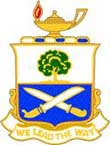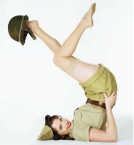JeffroK
Posts: 6391
Joined: 1/26/2005
Status: offline

|
quote:
ORIGINAL: jwilkerson
For years, I thought many British combat units called themselves "regiments" when they were really "battalions" - but I think I finally figured out - this isn't really the case.
When the Brits say "2nd Para Regt" for example - this is "short hand" for "2nd Battalion of the Parachute Regiment". Or like "2nd RTR" - is "2nd Battalion of the Royal Tank Regiment". It is just the abbreviation system that confuses some of us into thinking the Brits are calling their battalions - regiments.
Now for AT units or Engineer units - the "regiment" is a "battalion" idea seems to be real - but for infantry and armour - I think it is just an abbreviation thingy.
However, I do recall some old SPI games that showed all the "2RTR" type units with the regiment III size indicator - clearly this was wrong!
Except,
In WW2 it was 2nd Parachute Bn as "The Parachute Regiment" had not been born,your understanding is correct for current understanding.
Plus, and a Brit Tanker could confirm this, it was 2nd Royal Tank Regiment, not 2nd Bn, Royal Tank Regiment.
Wiki says:
In the nineteenth-century (and before) British Army, regiments of infantry raised several battalions, which were often deployed separately. This practice remained into the modern era—in the First World War, it was common to see twenty or more battalions with a single regimental title. However, this practice did not hold for the cavalry regiments, which traditionally were only of limited size; in the modern era, this meant that each regiment would only constitute one battalion.
As a result, it became traditional for a battalion-level unit of cavalry to be referred to as a "regiment". This was not as confusing as it may seem, since where other armies would use "regiment" for a unit of two to four battalions, the British Army used "brigade". Hence, an infantry brigade could consist of three battalions of infantry, but a cavalry brigade of equivalent size would have three regiments.
In the inter-war period, the British Army began to mechanise, with cavalry regiments giving up their horses in favour of armoured cars or light tanks. (The first regiment to do so was the 11th Hussars, in 1928; the last the Royal Scots Greys in 1941). As a result, it became common to refer to any armoured unit as a "regiment" rather than a "battalion"—the 11th Hussars were not merely an armoured-car battalion, but the whole of the regiment. In 1945, this usage became formal; all armoured battalions were henceforth referred to as regiments.
The Royal Tank Regiment is itself a regiment of the British Army, part of the Royal Armoured Corps. However, as a result of the above, both its "battalions" are formally titled regiments. This can cause some confusion, with the regiment currently being composed of two regiments.
Dont worry, even Nafziger has made a mess of the British System.
Basically, a British Regiment, for example The Rifle Brigade(Prince Consorts Own), would have 1 or 2 Bns during peacetime and expand in wartime from Territorial Army and war raised units, The Rifle Brigade formed 17 battalions for service in WW2.
So now we have Battalions, Regiments and Brigades of the same unit, why bother to sort it all out
_____________________________
Interdum feror cupidine partium magnarum Europae vincendarum
|
 Printable Version
Printable Version
















 New Messages
New Messages No New Messages
No New Messages Hot Topic w/ New Messages
Hot Topic w/ New Messages Hot Topic w/o New Messages
Hot Topic w/o New Messages Locked w/ New Messages
Locked w/ New Messages Locked w/o New Messages
Locked w/o New Messages Post New Thread
Post New Thread